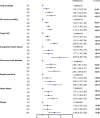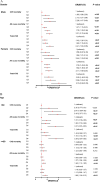Association of C-reactive protein-triglyceride glucose index with the incidence and mortality of cardiovascular disease: a retrospective cohort study
- PMID: 40750895
- PMCID: PMC12317521
- DOI: 10.1186/s12933-025-02835-0
Association of C-reactive protein-triglyceride glucose index with the incidence and mortality of cardiovascular disease: a retrospective cohort study
Abstract
Background: The C-reactive protein-triglyceride-glucose index (CTI) has emerged as an innovative composite marker for evaluating metabolic-inflammatory dysregulation, integrating markers of insulin resistance and systemic inflammation. However, the association between CTI and cardiovascular disease (CVD) or its mortality has rarely been studied. This study sought to examine CTI's associations with CVD mortality, CVD incidence, and all-cause mortality.
Methods: This study included 8,679 adults from the National Health and Nutrition Examination Survey (NHANES) 2001-2010, 2015-2018. The CTI was derived as: 0.412* Ln (CRP [mg/L]) + Ln (TG [mg/dl] × FPG [mg/dl])/2, with participants categorized into quartiles. We employed Kaplan-Meier curves, cox proportional hazards model, logistic regression analyses, and restricted cubic spline (RCS) to evaluate CTI's associations with CVD mortality, total CVD incidence, and all-cause mortality across sex-stratified, age-specific, and glycemic subgroups.
Results: In this study, CTI was significantly and positively associated with CVD mortality, total CVD incidence, and all-cause mortality. CTI significantly predicted both CVD mortality (HR 2.28 [1.69-3.24]) and all-cause mortality (HR 2.14 [1.76-2.55]). Additionally, the CTI index correlated with the risk of total CVD (OR 2.85, 95% CI 2.32-3.52), congestive heart failure (OR 3.66, 95% CI 2.46-5.35), coronary heart disease (OR 2.82, 95% CI 1.95-3.97), angina pectoris (OR 2.85, 95% CI 1.89-4.22), heart attack (OR 2.59, 95% CI 1.89-3.52), and stroke (OR 2.86, 95% CI 2.00-3.85). Specifically, the association was similar between male and female, and similar in young participants and elderly participants. In different glycemic status, high levels of CTI were found to be linked to an increased risk of CVD in individuals without diabetes mellitus (DM). However, this association was not observed in individuals with DM.
Conclusions: Our analysis revealed that elevated CTI levels were significantly associated with CVD incidence and mortality. CTI may emerge as a unique predictive marker for CVD risk.
Keywords: All-cause mortality; C-reactive protein-triglyceride glucose index; Cardiovascular disease; Cardiovascular disease mortality; NHANES.
© 2025. The Author(s).
Conflict of interest statement
Declarations. Ethics approval and consent to participate: NHANES is conducted by the Centers for Disease Control and Prevention (CDC) and the National Center for Health Statistics (NCHS). And the NHANES study protocol was reviewed and approved by the NCHS Research Ethics Review Committee. All participants in NHANES provided written informed consent. Competing interests: The authors declare no competing interests.
Figures







References
-
- Vaduganathan M, Mensah GA, Turco JV, Fuster V, Roth GA. The global burden of cardiovascular diseases and risk: a compass for future health. J Am Coll Cardiol. 2022;80(25):2361–71 ((in eng)). - PubMed
-
- Zhao D, Liu J, Wang M, Zhang X, Zhou M. Epidemiology of cardiovascular disease in China: current features and implications. Nat Rev Cardiol. 2019;16(4):203–12 ((in eng)). - PubMed
-
- Virani SS, et al. Heart disease and stroke statistics-2020 update: a report from the american heart association. Circulation. 2020;141(9):e139–596 ((in eng)). - PubMed
MeSH terms
Substances
Grants and funding
LinkOut - more resources
Full Text Sources
Medical
Research Materials
Miscellaneous

